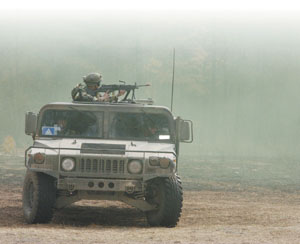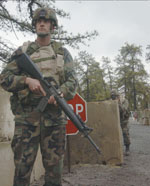 |
| A machine gunner takes aim on a Fort Dix training range. The base is implementing a wireless network that may connect ranges to the base network as early as this fall. |
Fort Dix wirelessly reaches out to provide network connectivity to remote training areas.
A wireless network initiative underway at New Jersey’s Fort Dix is extending broadband Internet service to remote training areas while halving the cost compared to the alternative fiber optics installation. The wireless plan takes advantage of emerging standard 802.16 wireless technology. It enables Army officials to stretch and optimize the base’s existing fiber optic-based network with a new long-range, point-to-multipoint wireless solution.
“It’s primarily an alternate backbone solution to replace fiber,” says Tom Badders, wireless networking director, Telos Corporation, Ashburn, Virginia, about the no-line-of-sight capability. “We’re bringing service to where they don’t have service or where they have service but want to improve the bandwidth,” he adds.
Fort Dix’s Directorate of Information Management (DOIM) contracted Telos to conduct a site survey and network design aimed at providing broadband network connectivity to outlying range areas and unconnected buildings. The survey also looked at boosting network access speeds to facilities with slow, outdated fiber optic connections.
Telos’ solution mixes the base’s existing wired capabilities with available wireless local area network (WLAN) technologies, including those based on Institute of Electrical and Electronic Engineers Incorporated (IEEE) standard 802.11 wireless fidelity (Wi-Fi) and IEEE 802.16 worldwide interoperability for microwave access (WiMAX) standards. WiMAX provides speeds up to 72 megabits per second at a maximum range of 50 miles in point-to-point mode or 15 miles in point-to-multipoint mode.
The reserve and active duty training base has an immediate need to network deploying units preparing for operations in Iraq, Afghanistan and other hot spots as well as the permanent Army staff training them, says Donald Rhodes, information technology specialist at Fort Dix’s DOIM. Based on Telos’ site survey and proposed network design, Army officials are planning to release a request for proposal comprising $500,000 of a projected $2.7 million program to implement wireless service quickly to those areas. The first step will be to wirelessly connect the base’s forward operating base (FOB)—a remote tent city where deploying units reside while training for real-world operations—and an outlying Army-staffed operations facility that coordinates and executes training activities, Rhodes says. That piece should be implemented as early as this fall, he adds.
Currently, FOB-located units preparing for deployment are using clunky, inconsistent cell phone service to try to connect to the Internet. To provide reliable, high-speed connection, Fort Dix will affix WiMAX capabilities to an existing radio tower that is linked to the base’s fiber optic network and then will establish either wired or 802.11 wireless networking at the WiMAX endpoint. The training operations center will be similarly connected. “Those facilities don’t have any type of communications infrastructure, so running fiber was very cost prohibitive,” Rhodes says.
In fact, installing fiber from the base network to the tactical training areas would cost roughly $150,000, Rhodes estimates. The WiMAX solution proposes to cut that dollar amount in half, he says. It also eliminates the hassle of tearing up roads and securing permission to dig up the base’s protected pineland areas. If funding comes through, DOIM will implement the wireless plan within two months—three times faster than a fiber optic solution could be deployed, Rhodes explains.
Using WiMAX is like dragging a fiber optic cable to an outlying location without the mess, Badders notes. At the endpoint of that remote WiMAX-connected location, network engineers can create an 802.11 WLAN, or hot spot, which allows wireless users to roam around a specific area and maintain connectivity, he adds. Or they can string together a wired network at the WiMAX endpoint.
Not only will the new wireless network access allow trainers and trainees to coordinate their efforts better, but also it will provide soldiers preparing to leave families and friends a way to communicate via the Internet during Fort Dix’s 30-day-plus training cycle.
In addition, base officials are planning to provide wireless Internet service to its cantonment areas, or temporary billeting areas, where transient soldiers can access the network. Fort Dix buildings wired with outdated fiber optics and those not wired at all will be targeted for a wireless solution, Rhodes says. “If we have 20 or 30 users in a building doing typical network-type activity, we would use WiMAX to get to the building and then wire the building,” he adds.
 |
| Soldiers training for combat operations at Fort Dix’s forward operating base will soon enjoy wireless Internet connection in the base’s outlying range areas. |
But wireless is not always the best option. “We don’t anticipate replacing existing wired networks with wireless,”
Rhodes says. As the initiative’s project manager,
Rhodes must determine the best capabilities-driven solution for the base’s requirements. During his investigation of wireless technology,
Rhodes says he uncovered problems with poor wireless performance in bandwidth-intensive applications. “Wireless can be a real problem,”
Rhodes says.
Fort Dix will stick with its existing wired networks because building wireless ones “is a learning process,” he adds. In fact, long-term plans are underway to complete the other half of a fiber optic ring, which will eventually encircle the range area,
Rhodes says. And the base is currently upgrading existing fiber optics to allow 1-gigabit-per-second capability.
Emerging wireless technology also raises new network security issues. Telos’ Badders warns that the embedded encryption accompanying an enterprise wireless architecture does not provide sufficient protection to solve security requirements. Telos’ wireless network design incorporates added protections that will provide National Institute of Standards and Technology (NIST) Federal Information Processing Standards Publication 140-2 (FIPS 140-2) compliant security for sensitive but not classified messaging. The base’s wired network will still handle secured classified communication requirements, Rhodes shares. But, Badders says, wireless network security has developed sophisticated and effective network security solutions that parallel its wired counterpart. Both types of networks take advantage of intrusion detection systems, designated approval authority, certification and accreditation processes, and other security devices and protocols. Wireless intrusion detection devices monitoring the network for rogue access points can lock out any unauthorized user, Badders says. If a hacker with a high-intensity antenna tries to infiltrate the network, Telos’ wireless security solution will not only recognize and lock out the unauthorized user, but it also will pinpoint within three meters the intruder’s physical location. “You can go track him down,” Badders says. As wireless network security evolves and IEEE ratifies its wireless security protocol 802.11i, the need for border protection devices may subside, he adds.
Fort Dix’s wireless network also has to contend with potential interference from devices that share its spectrum. Operating on the unlicensed 5.8-gigahertz band, Telos’ proposed WiMAX network design is susceptible to interference from devices such as wireless telephones that also use the spectrum. Badders says those issues are easily solved after a site survey identifies what is operating in the environment. “You can set those 2.4-gigahertz or 5.8-gigahertz phones to transmit and receive only on a specific frequency or channel,” he says. Or, network administrators can configure the WLAN or WiMAX link to use a specific channel, he adds.
Fort Dix’s wireless implementation will rely heavily on available commercial solutions. As the technology evolves, the industry’s adherence to set standards will make it easier to adjust, Rhodes says. Unlike for the radio industry where proprietary systems were the norm, wireless manufacturers have built to common standards. “You don’t have to do a forklift solution when you upgrade,” he says. “We want to expand as technology changes.”
Rhodes says he envisions using emerging WiMAX subscriber-based equipment to support law enforcement and emergency services missions on the base. The wireless cloud created by WLAN technology could support wireless perimeter cameras and vehicle-mounted mobile data terminals that feed back to the base’s main network. Police could achieve greater situational awareness by viewing an area before arriving on the scene. They could store reports in their vehicles until they hit a wireless hot spot where they could transmit information back to the base’s main network, Rhodes says.
“The technology is changing so fast that it’s hard to keep up,” he adds. And new upgrades are available on the market even before standards are approved and network plans are fully developed. When Fort Dix’s Morale, Welfare and Recreation Programs office began implementing it’s own wireless network to provide Internet services to military members, DOIM officials stepped in. “We put our foot down and said there will be only one wireless network on the installation,” Rhodes says. The two entities and other agencies are partnering to centralize the effort to provide high-speed network connectivity to anyone who needs it.
Web Resources
Fort Dix: www.dix.army.mil
Institute of Electrical and Electronics Engineers Incorporated: www.ieee.org
The WiMAX Forum: www.WiMAXforum.org






Comments